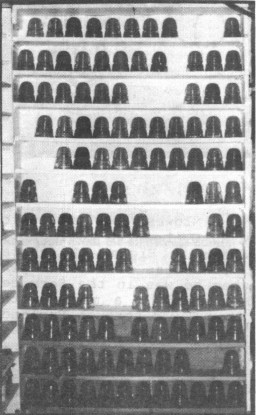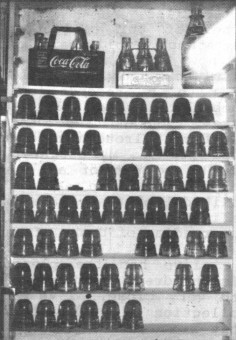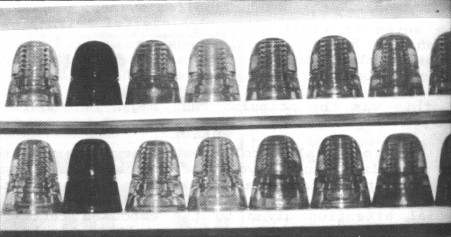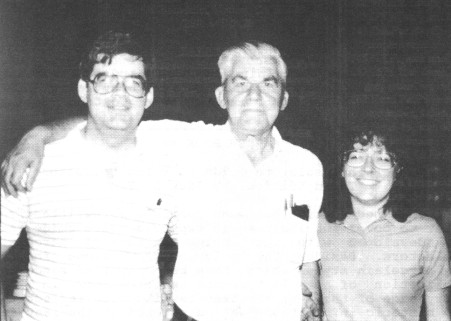Bea Lines
by H.G. "Bea" Hyve
Reprinted from "Crown Jewels of the Wire", May 1988, page 15
We're traveling to the Midwest now to visit my good friend and fellow H. G.
beehive collector, Paul Rosenberger. Paul lives in Elgin, IL, where he was born
April 26, 1921. He has lived in Elgin all his life except for when he was in the
Service from 1942 to 1945. Paul served as a medic with the 745th Tank Battalion
from Texas through England, D-Day, France, Belgium, Germany, and on V-E Day he
was in Eger, Czechoslovakia.
Paul says, "I had just began working as an electroplater when the war
began, so I returned to electroplating, for a total of thirty-three years.
During these years I worked in every phase of this occupation; pickling,
oxidizing, burnishing, de-rusting/de-scaling, and part finishing. The real task
was the mixing of solutions and the plating of cadmium, zinc, copper, lead,
nickel, and chromium. The most dangerous to work with are lead and black nickel.
Cadmium, zinc, and copper all used powerful alkaline solutions high in cyanide
and caustic soda. The nickel, lead, and chrome solutions are acidic. During my
last two years of employment I was engaged in cadmium and zinc plating by a
non-electric process.
"I might add, that the day I retired, I put all these years out of my
mind. I had no intention of reliving all these experiences when I should began
to enjoy living. I retired when I was almost fifty-eight, mostly because the
children had left, and it was better for me to
look after my wife."

A part of Paul's H. C. Co. Petticoat
beehive collection showing letters A-L
Paul's wife's name is Clara Elaine née Wunderlich,
and he tells us, "We first met at my sister's home by some sort of
prearrangement. We could only see each other on Sunday because I worked nights
six days a week, and had to travel twenty miles by train to be together. We were
married September 25, 1948. Though she had a few hobbies of her own, her whole
world came to an end when she had a breakdown after the birth of our second
child in 1957, and she has had no hobbies or much of anything since."
Paul and Clara have two children; Paul Louis, who graduated from Northern
Illinois University, and after a couple of job movements, is now a computer
programmer, and Paula Ruth, who, after completing four years with a B.S. with
honors in Chemistry at the University of Illinois, went on to med-school there
and has been an active dentist for the past six years.
Paul became interested in insulators the first week of April 1968. He tells
us how it happened. "From the time my children were toddlers to teenagers,
I gave them a great deal of my time. Weekends especially were devoted to
chasing butterflies, flying kites, fishing, hiking, and all other things young
people enjoy. It was during one of our early spring jaunts into nature that we
stumbled upon a fallen telegraph pole, and out of curiosity picked up a couple
of insulators and stuffed them in our pockets. (They were Hemingray 42's). None
of our hikes (or later bike rides) were ever less than seven or eight miles, and when we returned, pooped and hungry, we all
began to exhibit some curiosity about the insulators. A casual glance at the
poles across the street showed evidence that they came in different shapes and
sizes. And this was the stimulus that began our addiction."
Paul originally collected everything; glass and porcelain -- huge two- and
three-piece items to small radio antenna insulators. But he now specializes in
H. G. Co. Petticoat beehives, with special attention given to the embossed
letters. He now has 175 pieces in this specialty collection. His quest is like
colors with different letters. He has found the pieces lettered G, H, J, and K
to be the most abundant, with A, B, C, (backwards) G, and (backwards) N to be the most difficult to
obtain. Paul's most wanted piece is an H. G. Co. Petticoat beehive that is a
real lemon or banana yellow color. "I know there are at least two of these
in existence, so there may be one more somewhere for my collection," says
Paul, hopefully.

Beehives with letter M and no letter. Also showing
tail-end of Coke
collection. (Note narrow skirt beehive
in aqua on row 7, 4th from left, above
dot)
His favorite insulators are, strange as it may seem, not from his hobby
specialty, but are two insulators he has displayed in his bedroom. They are both
carnival glass; a Pyrex 63 and 662. They are sitting atop each of his stereo
speakers. Their beauty is why they are his favorites.

Close-up of a dark amber, sapphire blue (top row) and several other fine
blues
Paul states, "I have instilled curiosity in my two children and from
very young on to today, we (as a threesome) have been collecting a number of things. Some collections they began while in school have fallen by the
wayside; insects, butterflies, leaves, and small mineral specimens. Other of our
collections remain dormant, such as stamps, political buttons, and Coke bottles.
So now that the children are adults, we collect insulators. My son collects
jukeboxes. I collect 78 r. p. m. records (only of my favorites, which number
thirty or forty entertainers and perhaps three thousand records). I also collect
Union Pacific Railroad timetables and a few other railroad items. My daughter,
having less free time, is in and out of all the hobbies and is fairly well
informed on each. Her major collecting is political buttons. She and I (though
not a hobby) delight ourselves in visiting art museums and the reading of books
of and on art."
I've had the pleasure of meeting Paul and his children, and they are
certainly a nice family, and very close. I've also seen Paul's beautiful
collection of beehives, and he has several there that just make me drool. We
correspond regularly and enjoy discussing our mutual specialty; new finds,
colors, etc.
In conclusion, Paul "would like to suggest we urge the younger people to
walk more rail lines. Forget what is on the poles; that is mostly junk. It is what has come down
from the poles over the years -- though not easy to find -- that will produce the
reward for looking." That is good advice. So start looking! There are still
many good insulators buried out there somewhere.

Paul Rosenberger (center) with Paul and Paula
|
